Competitive Strategy Report: Australian Higher Education
VerifiedAdded on 2020/09/17
|11
|3210
|29
Report
AI Summary
This report provides a comprehensive analysis of the competitive strategies employed by the University of Sydney and Monash University, two prominent educational institutions in Australia. It examines their strategic approaches, strengths, and weaknesses within the higher education sector. The report delves into the application of the CAGE framework (Culture, Administration, Geography, and Economics) to assess the impact of these factors on the universities' operations, particularly in the context of cultural and administrative differences between Australia and Malaysia. The analysis covers various aspects, including strategic planning, resource allocation, and the influence of geographical and economic factors on the universities' performance. The report also highlights the importance of adapting to cultural differences and administrative complexities to maintain a competitive edge in the global education market. Finally, the report provides insights into how these universities can sustain their performance and adapt to changes in the educational landscape.
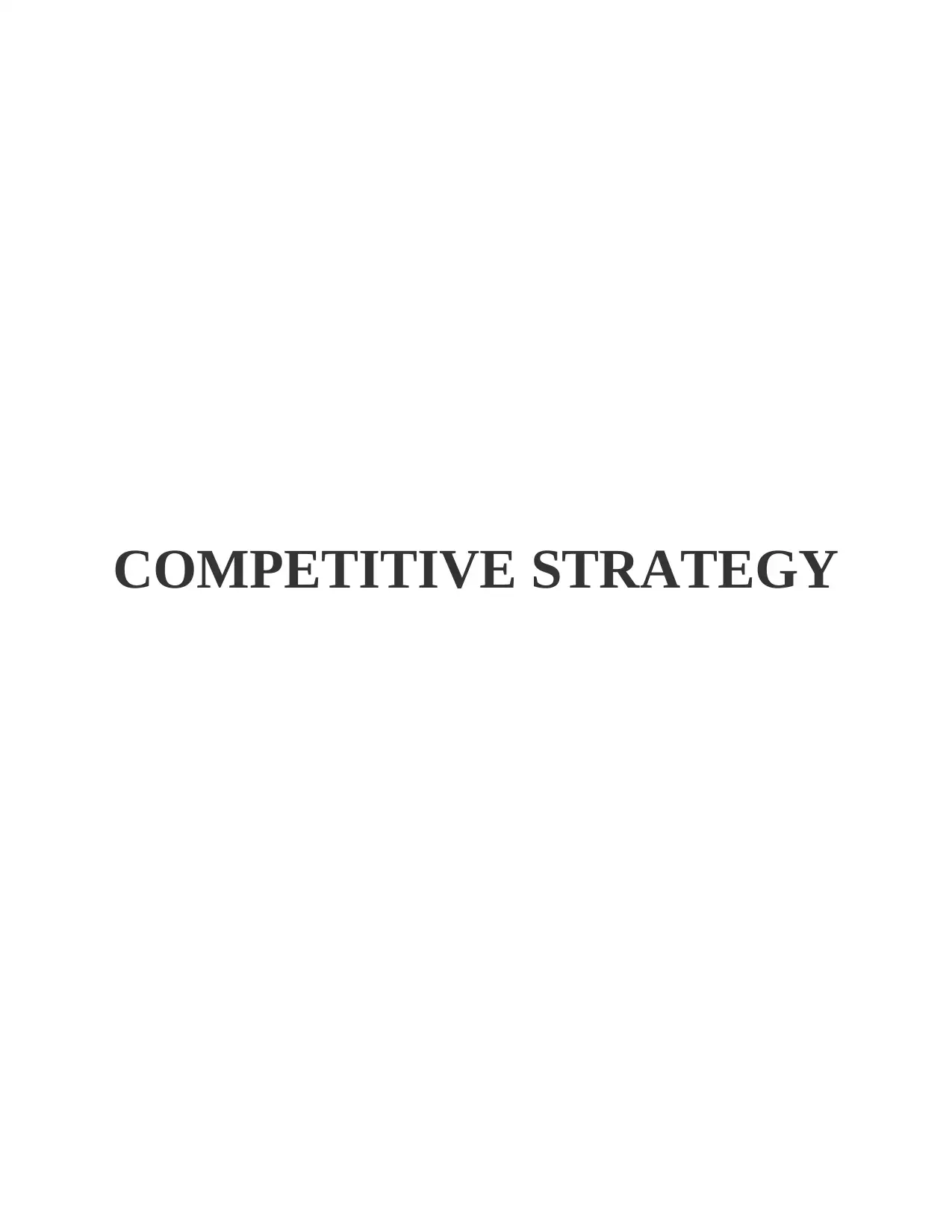
COMPETITIVE STRATEGY
Paraphrase This Document
Need a fresh take? Get an instant paraphrase of this document with our AI Paraphraser
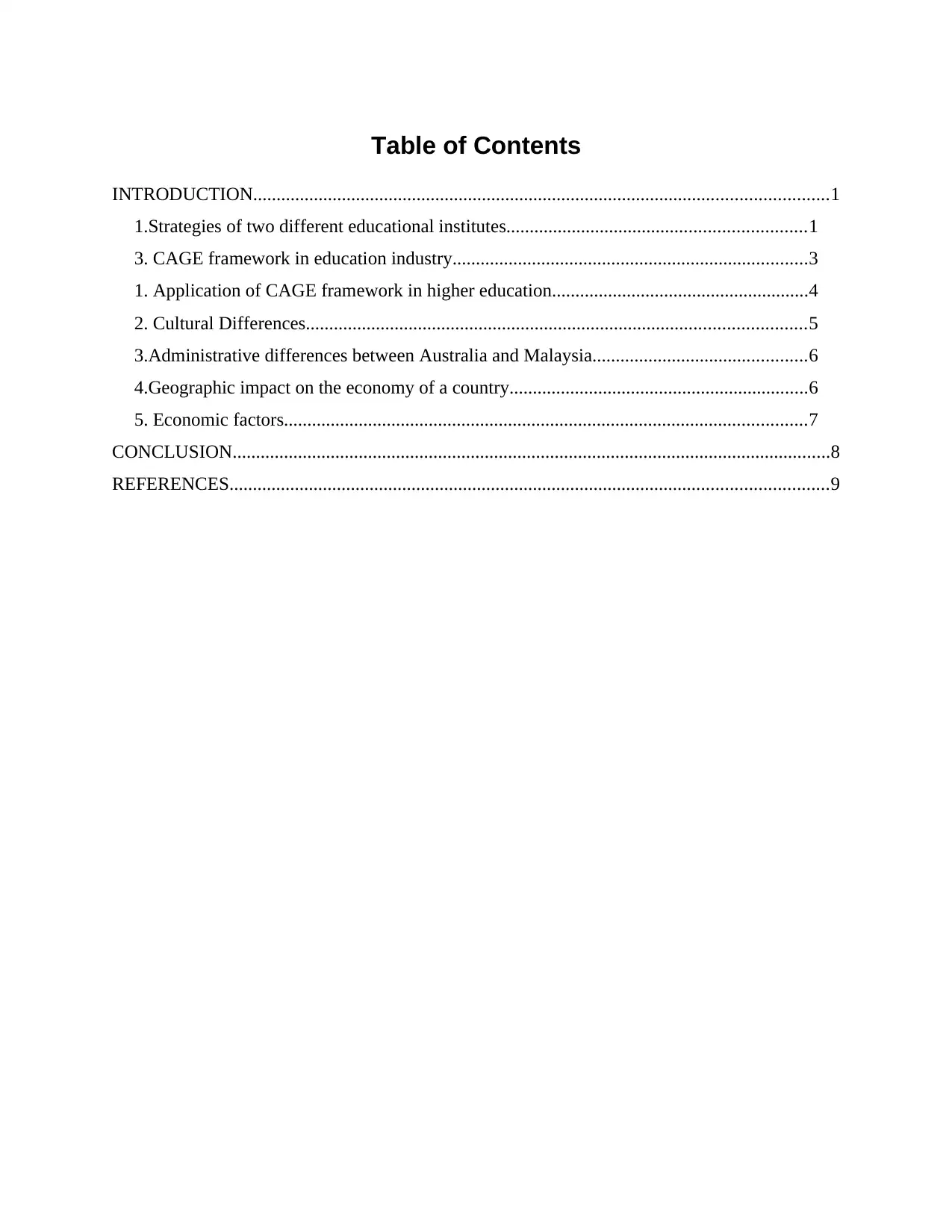
Table of Contents
INTRODUCTION...........................................................................................................................1
1.Strategies of two different educational institutes................................................................1
3. CAGE framework in education industry............................................................................3
1. Application of CAGE framework in higher education.......................................................4
2. Cultural Differences...........................................................................................................5
3.Administrative differences between Australia and Malaysia..............................................6
4.Geographic impact on the economy of a country................................................................6
5. Economic factors................................................................................................................7
CONCLUSION................................................................................................................................8
REFERENCES................................................................................................................................9
INTRODUCTION...........................................................................................................................1
1.Strategies of two different educational institutes................................................................1
3. CAGE framework in education industry............................................................................3
1. Application of CAGE framework in higher education.......................................................4
2. Cultural Differences...........................................................................................................5
3.Administrative differences between Australia and Malaysia..............................................6
4.Geographic impact on the economy of a country................................................................6
5. Economic factors................................................................................................................7
CONCLUSION................................................................................................................................8
REFERENCES................................................................................................................................9
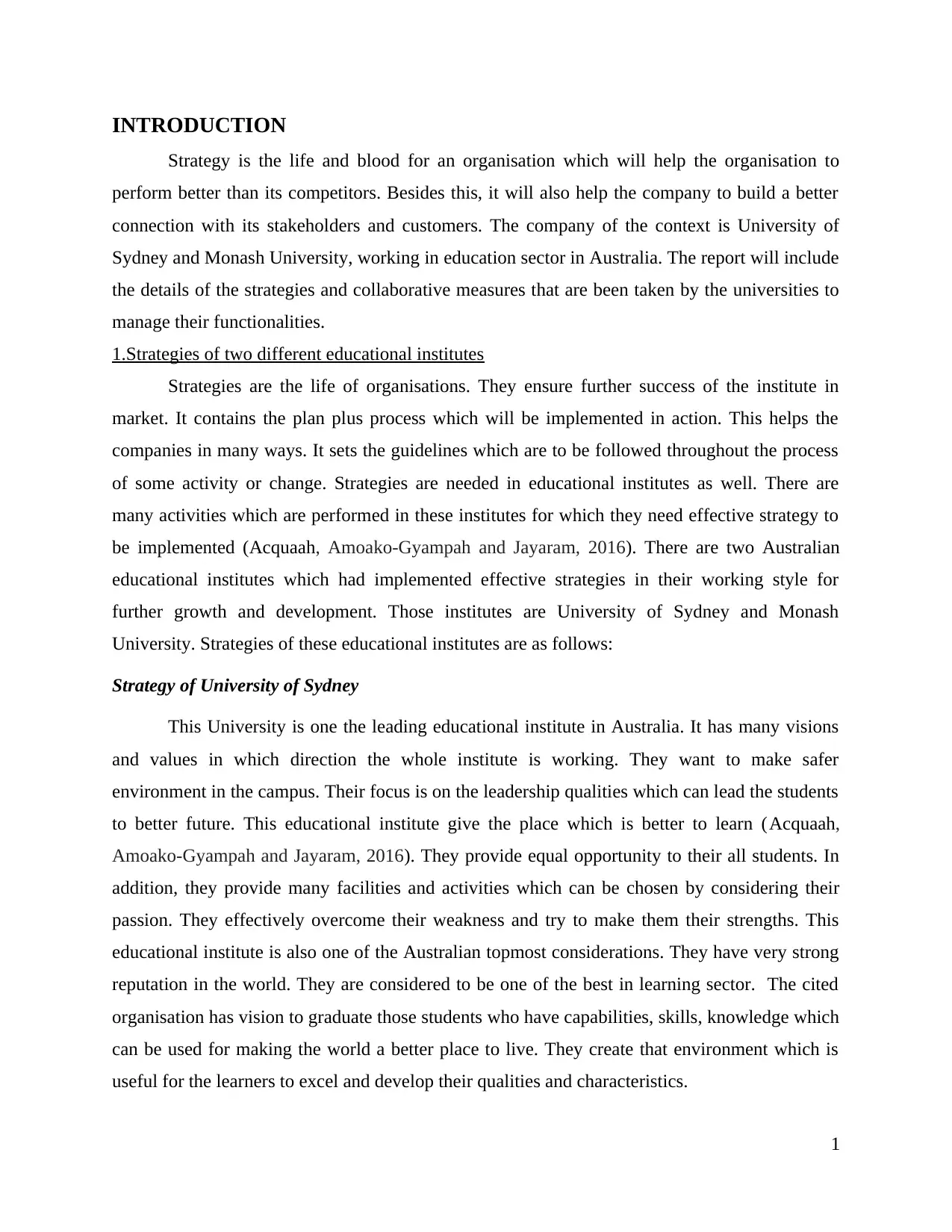
INTRODUCTION
Strategy is the life and blood for an organisation which will help the organisation to
perform better than its competitors. Besides this, it will also help the company to build a better
connection with its stakeholders and customers. The company of the context is University of
Sydney and Monash University, working in education sector in Australia. The report will include
the details of the strategies and collaborative measures that are been taken by the universities to
manage their functionalities.
1.Strategies of two different educational institutes
Strategies are the life of organisations. They ensure further success of the institute in
market. It contains the plan plus process which will be implemented in action. This helps the
companies in many ways. It sets the guidelines which are to be followed throughout the process
of some activity or change. Strategies are needed in educational institutes as well. There are
many activities which are performed in these institutes for which they need effective strategy to
be implemented (Acquaah, Amoako-Gyampah and Jayaram, 2016). There are two Australian
educational institutes which had implemented effective strategies in their working style for
further growth and development. Those institutes are University of Sydney and Monash
University. Strategies of these educational institutes are as follows:
Strategy of University of Sydney
This University is one the leading educational institute in Australia. It has many visions
and values in which direction the whole institute is working. They want to make safer
environment in the campus. Their focus is on the leadership qualities which can lead the students
to better future. This educational institute give the place which is better to learn (Acquaah,
Amoako-Gyampah and Jayaram, 2016). They provide equal opportunity to their all students. In
addition, they provide many facilities and activities which can be chosen by considering their
passion. They effectively overcome their weakness and try to make them their strengths. This
educational institute is also one of the Australian topmost considerations. They have very strong
reputation in the world. They are considered to be one of the best in learning sector. The cited
organisation has vision to graduate those students who have capabilities, skills, knowledge which
can be used for making the world a better place to live. They create that environment which is
useful for the learners to excel and develop their qualities and characteristics.
1
Strategy is the life and blood for an organisation which will help the organisation to
perform better than its competitors. Besides this, it will also help the company to build a better
connection with its stakeholders and customers. The company of the context is University of
Sydney and Monash University, working in education sector in Australia. The report will include
the details of the strategies and collaborative measures that are been taken by the universities to
manage their functionalities.
1.Strategies of two different educational institutes
Strategies are the life of organisations. They ensure further success of the institute in
market. It contains the plan plus process which will be implemented in action. This helps the
companies in many ways. It sets the guidelines which are to be followed throughout the process
of some activity or change. Strategies are needed in educational institutes as well. There are
many activities which are performed in these institutes for which they need effective strategy to
be implemented (Acquaah, Amoako-Gyampah and Jayaram, 2016). There are two Australian
educational institutes which had implemented effective strategies in their working style for
further growth and development. Those institutes are University of Sydney and Monash
University. Strategies of these educational institutes are as follows:
Strategy of University of Sydney
This University is one the leading educational institute in Australia. It has many visions
and values in which direction the whole institute is working. They want to make safer
environment in the campus. Their focus is on the leadership qualities which can lead the students
to better future. This educational institute give the place which is better to learn (Acquaah,
Amoako-Gyampah and Jayaram, 2016). They provide equal opportunity to their all students. In
addition, they provide many facilities and activities which can be chosen by considering their
passion. They effectively overcome their weakness and try to make them their strengths. This
educational institute is also one of the Australian topmost considerations. They have very strong
reputation in the world. They are considered to be one of the best in learning sector. The cited
organisation has vision to graduate those students who have capabilities, skills, knowledge which
can be used for making the world a better place to live. They create that environment which is
useful for the learners to excel and develop their qualities and characteristics.
1
⊘ This is a preview!⊘
Do you want full access?
Subscribe today to unlock all pages.

Trusted by 1+ million students worldwide
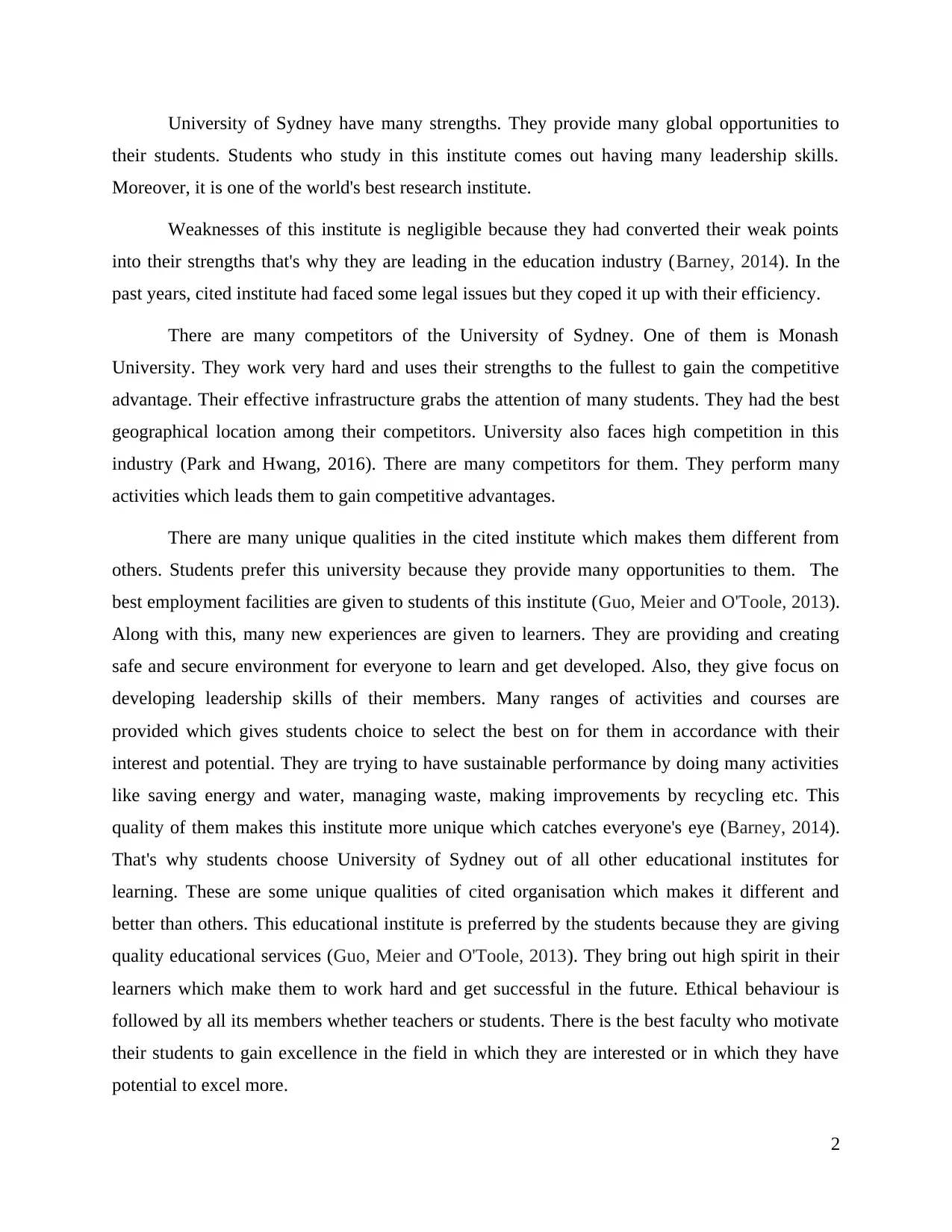
University of Sydney have many strengths. They provide many global opportunities to
their students. Students who study in this institute comes out having many leadership skills.
Moreover, it is one of the world's best research institute.
Weaknesses of this institute is negligible because they had converted their weak points
into their strengths that's why they are leading in the education industry (Barney, 2014). In the
past years, cited institute had faced some legal issues but they coped it up with their efficiency.
There are many competitors of the University of Sydney. One of them is Monash
University. They work very hard and uses their strengths to the fullest to gain the competitive
advantage. Their effective infrastructure grabs the attention of many students. They had the best
geographical location among their competitors. University also faces high competition in this
industry (Park and Hwang, 2016). There are many competitors for them. They perform many
activities which leads them to gain competitive advantages.
There are many unique qualities in the cited institute which makes them different from
others. Students prefer this university because they provide many opportunities to them. The
best employment facilities are given to students of this institute (Guo, Meier and O'Toole, 2013).
Along with this, many new experiences are given to learners. They are providing and creating
safe and secure environment for everyone to learn and get developed. Also, they give focus on
developing leadership skills of their members. Many ranges of activities and courses are
provided which gives students choice to select the best on for them in accordance with their
interest and potential. They are trying to have sustainable performance by doing many activities
like saving energy and water, managing waste, making improvements by recycling etc. This
quality of them makes this institute more unique which catches everyone's eye (Barney, 2014).
That's why students choose University of Sydney out of all other educational institutes for
learning. These are some unique qualities of cited organisation which makes it different and
better than others. This educational institute is preferred by the students because they are giving
quality educational services (Guo, Meier and O'Toole, 2013). They bring out high spirit in their
learners which make them to work hard and get successful in the future. Ethical behaviour is
followed by all its members whether teachers or students. There is the best faculty who motivate
their students to gain excellence in the field in which they are interested or in which they have
potential to excel more.
2
their students. Students who study in this institute comes out having many leadership skills.
Moreover, it is one of the world's best research institute.
Weaknesses of this institute is negligible because they had converted their weak points
into their strengths that's why they are leading in the education industry (Barney, 2014). In the
past years, cited institute had faced some legal issues but they coped it up with their efficiency.
There are many competitors of the University of Sydney. One of them is Monash
University. They work very hard and uses their strengths to the fullest to gain the competitive
advantage. Their effective infrastructure grabs the attention of many students. They had the best
geographical location among their competitors. University also faces high competition in this
industry (Park and Hwang, 2016). There are many competitors for them. They perform many
activities which leads them to gain competitive advantages.
There are many unique qualities in the cited institute which makes them different from
others. Students prefer this university because they provide many opportunities to them. The
best employment facilities are given to students of this institute (Guo, Meier and O'Toole, 2013).
Along with this, many new experiences are given to learners. They are providing and creating
safe and secure environment for everyone to learn and get developed. Also, they give focus on
developing leadership skills of their members. Many ranges of activities and courses are
provided which gives students choice to select the best on for them in accordance with their
interest and potential. They are trying to have sustainable performance by doing many activities
like saving energy and water, managing waste, making improvements by recycling etc. This
quality of them makes this institute more unique which catches everyone's eye (Barney, 2014).
That's why students choose University of Sydney out of all other educational institutes for
learning. These are some unique qualities of cited organisation which makes it different and
better than others. This educational institute is preferred by the students because they are giving
quality educational services (Guo, Meier and O'Toole, 2013). They bring out high spirit in their
learners which make them to work hard and get successful in the future. Ethical behaviour is
followed by all its members whether teachers or students. There is the best faculty who motivate
their students to gain excellence in the field in which they are interested or in which they have
potential to excel more.
2
Paraphrase This Document
Need a fresh take? Get an instant paraphrase of this document with our AI Paraphraser
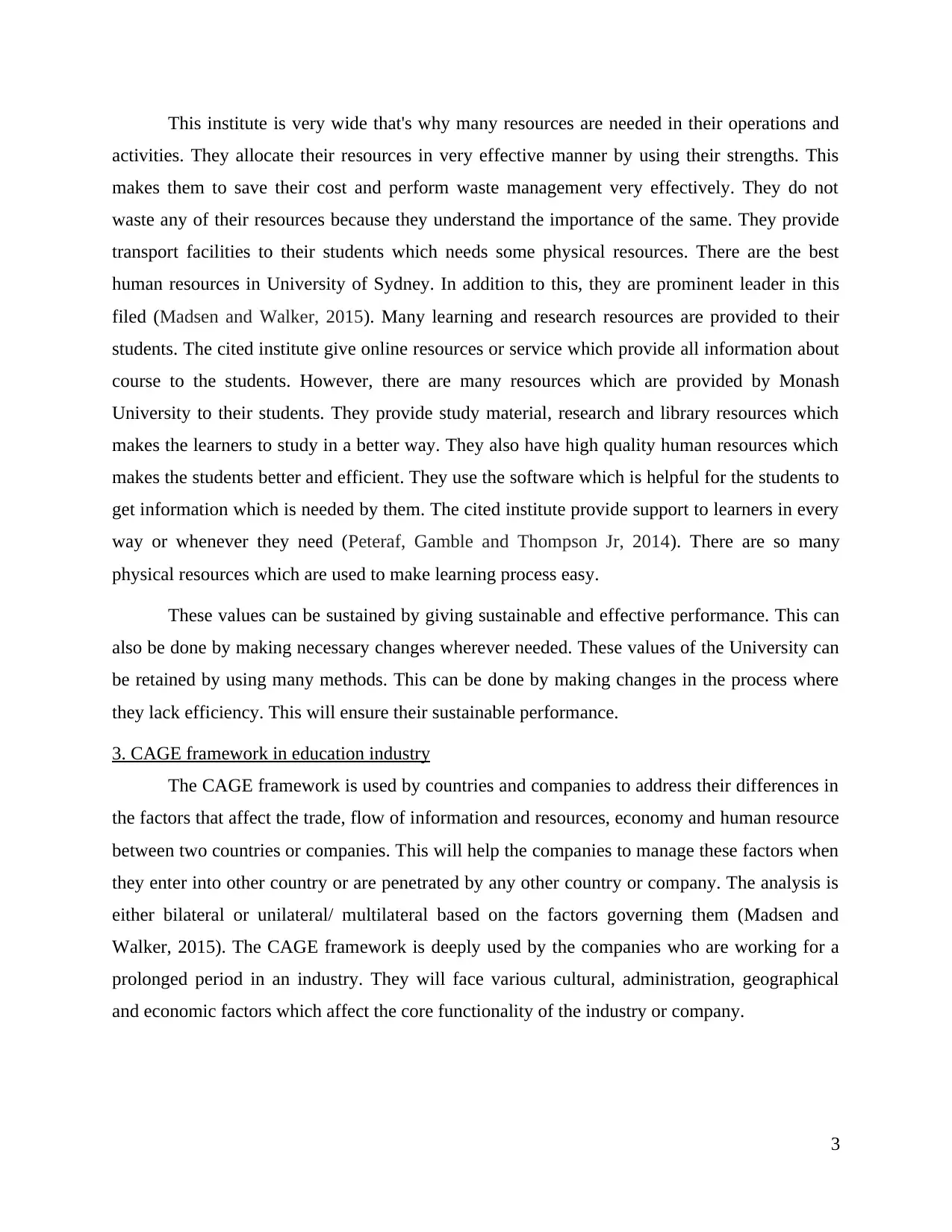
This institute is very wide that's why many resources are needed in their operations and
activities. They allocate their resources in very effective manner by using their strengths. This
makes them to save their cost and perform waste management very effectively. They do not
waste any of their resources because they understand the importance of the same. They provide
transport facilities to their students which needs some physical resources. There are the best
human resources in University of Sydney. In addition to this, they are prominent leader in this
filed (Madsen and Walker, 2015). Many learning and research resources are provided to their
students. The cited institute give online resources or service which provide all information about
course to the students. However, there are many resources which are provided by Monash
University to their students. They provide study material, research and library resources which
makes the learners to study in a better way. They also have high quality human resources which
makes the students better and efficient. They use the software which is helpful for the students to
get information which is needed by them. The cited institute provide support to learners in every
way or whenever they need (Peteraf, Gamble and Thompson Jr, 2014). There are so many
physical resources which are used to make learning process easy.
These values can be sustained by giving sustainable and effective performance. This can
also be done by making necessary changes wherever needed. These values of the University can
be retained by using many methods. This can be done by making changes in the process where
they lack efficiency. This will ensure their sustainable performance.
3. CAGE framework in education industry
The CAGE framework is used by countries and companies to address their differences in
the factors that affect the trade, flow of information and resources, economy and human resource
between two countries or companies. This will help the companies to manage these factors when
they enter into other country or are penetrated by any other country or company. The analysis is
either bilateral or unilateral/ multilateral based on the factors governing them (Madsen and
Walker, 2015). The CAGE framework is deeply used by the companies who are working for a
prolonged period in an industry. They will face various cultural, administration, geographical
and economic factors which affect the core functionality of the industry or company.
3
activities. They allocate their resources in very effective manner by using their strengths. This
makes them to save their cost and perform waste management very effectively. They do not
waste any of their resources because they understand the importance of the same. They provide
transport facilities to their students which needs some physical resources. There are the best
human resources in University of Sydney. In addition to this, they are prominent leader in this
filed (Madsen and Walker, 2015). Many learning and research resources are provided to their
students. The cited institute give online resources or service which provide all information about
course to the students. However, there are many resources which are provided by Monash
University to their students. They provide study material, research and library resources which
makes the learners to study in a better way. They also have high quality human resources which
makes the students better and efficient. They use the software which is helpful for the students to
get information which is needed by them. The cited institute provide support to learners in every
way or whenever they need (Peteraf, Gamble and Thompson Jr, 2014). There are so many
physical resources which are used to make learning process easy.
These values can be sustained by giving sustainable and effective performance. This can
also be done by making necessary changes wherever needed. These values of the University can
be retained by using many methods. This can be done by making changes in the process where
they lack efficiency. This will ensure their sustainable performance.
3. CAGE framework in education industry
The CAGE framework is used by countries and companies to address their differences in
the factors that affect the trade, flow of information and resources, economy and human resource
between two countries or companies. This will help the companies to manage these factors when
they enter into other country or are penetrated by any other country or company. The analysis is
either bilateral or unilateral/ multilateral based on the factors governing them (Madsen and
Walker, 2015). The CAGE framework is deeply used by the companies who are working for a
prolonged period in an industry. They will face various cultural, administration, geographical
and economic factors which affect the core functionality of the industry or company.
3
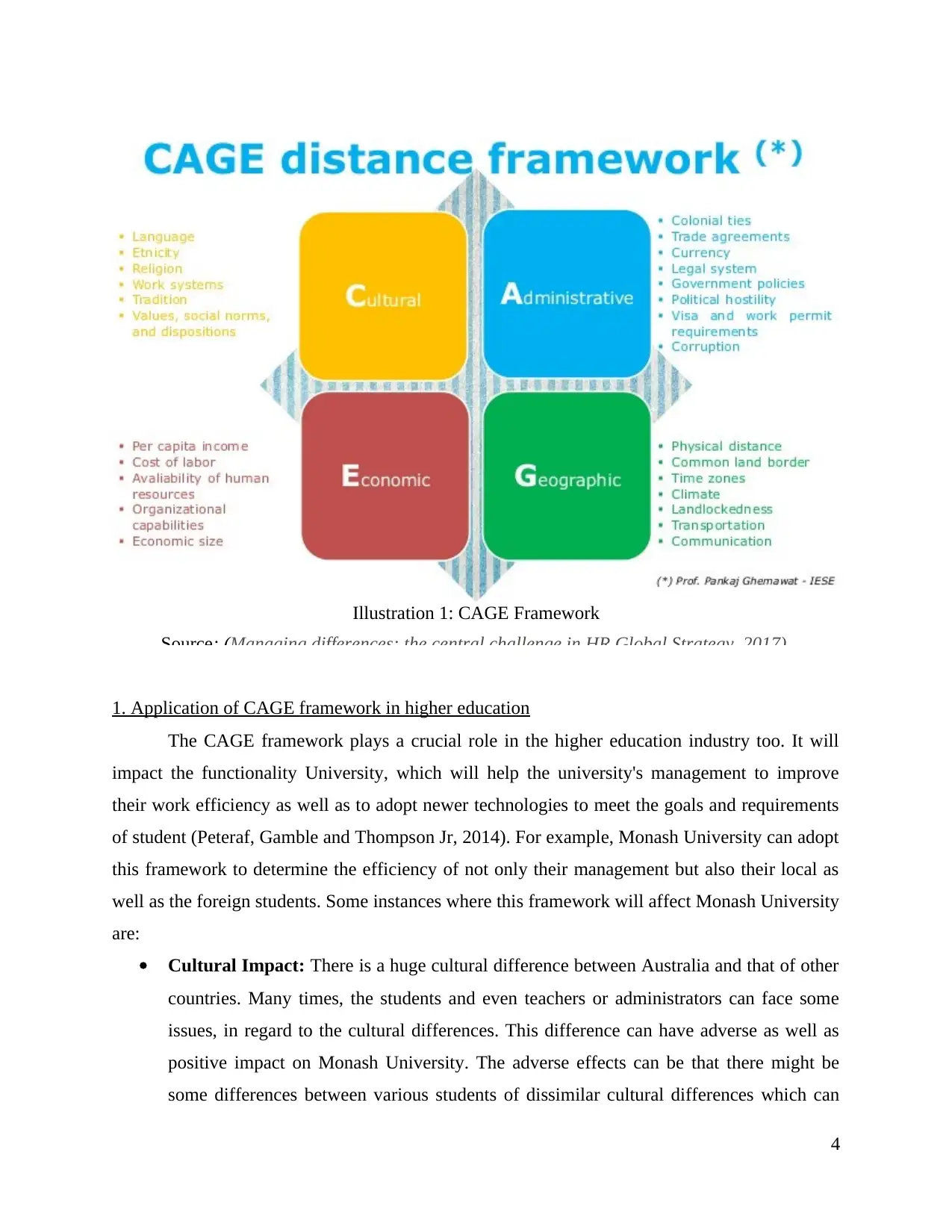
1. Application of CAGE framework in higher education
The CAGE framework plays a crucial role in the higher education industry too. It will
impact the functionality University, which will help the university's management to improve
their work efficiency as well as to adopt newer technologies to meet the goals and requirements
of student (Peteraf, Gamble and Thompson Jr, 2014). For example, Monash University can adopt
this framework to determine the efficiency of not only their management but also their local as
well as the foreign students. Some instances where this framework will affect Monash University
are:
Cultural Impact: There is a huge cultural difference between Australia and that of other
countries. Many times, the students and even teachers or administrators can face some
issues, in regard to the cultural differences. This difference can have adverse as well as
positive impact on Monash University. The adverse effects can be that there might be
some differences between various students of dissimilar cultural differences which can
4
Illustration 1: CAGE Framework
Source: (Managing differences: the central challenge in HR Global Strategy, 2017).
The CAGE framework plays a crucial role in the higher education industry too. It will
impact the functionality University, which will help the university's management to improve
their work efficiency as well as to adopt newer technologies to meet the goals and requirements
of student (Peteraf, Gamble and Thompson Jr, 2014). For example, Monash University can adopt
this framework to determine the efficiency of not only their management but also their local as
well as the foreign students. Some instances where this framework will affect Monash University
are:
Cultural Impact: There is a huge cultural difference between Australia and that of other
countries. Many times, the students and even teachers or administrators can face some
issues, in regard to the cultural differences. This difference can have adverse as well as
positive impact on Monash University. The adverse effects can be that there might be
some differences between various students of dissimilar cultural differences which can
4
Illustration 1: CAGE Framework
Source: (Managing differences: the central challenge in HR Global Strategy, 2017).
⊘ This is a preview!⊘
Do you want full access?
Subscribe today to unlock all pages.

Trusted by 1+ million students worldwide
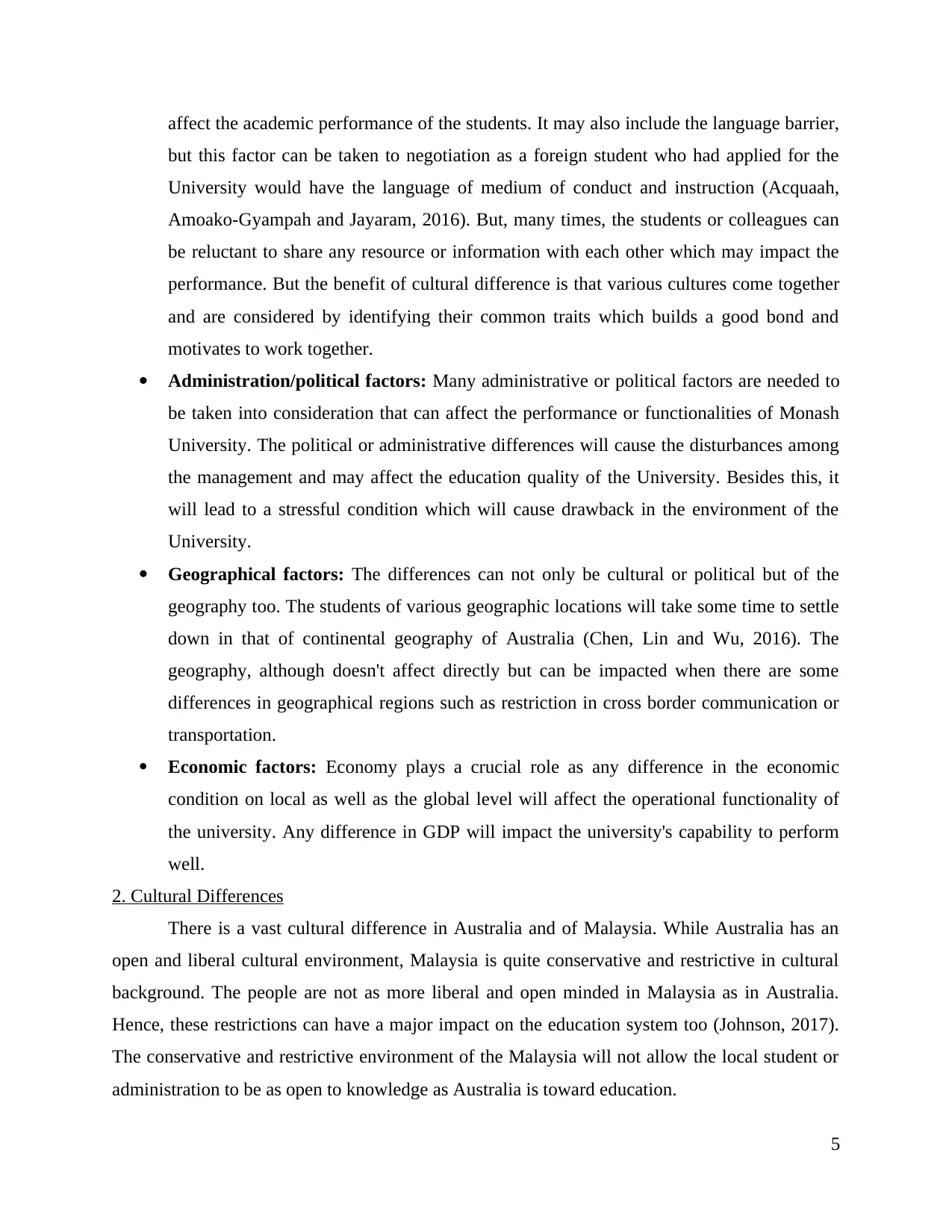
affect the academic performance of the students. It may also include the language barrier,
but this factor can be taken to negotiation as a foreign student who had applied for the
University would have the language of medium of conduct and instruction (Acquaah,
Amoako-Gyampah and Jayaram, 2016). But, many times, the students or colleagues can
be reluctant to share any resource or information with each other which may impact the
performance. But the benefit of cultural difference is that various cultures come together
and are considered by identifying their common traits which builds a good bond and
motivates to work together.
Administration/political factors: Many administrative or political factors are needed to
be taken into consideration that can affect the performance or functionalities of Monash
University. The political or administrative differences will cause the disturbances among
the management and may affect the education quality of the University. Besides this, it
will lead to a stressful condition which will cause drawback in the environment of the
University.
Geographical factors: The differences can not only be cultural or political but of the
geography too. The students of various geographic locations will take some time to settle
down in that of continental geography of Australia (Chen, Lin and Wu, 2016). The
geography, although doesn't affect directly but can be impacted when there are some
differences in geographical regions such as restriction in cross border communication or
transportation.
Economic factors: Economy plays a crucial role as any difference in the economic
condition on local as well as the global level will affect the operational functionality of
the university. Any difference in GDP will impact the university's capability to perform
well.
2. Cultural Differences
There is a vast cultural difference in Australia and of Malaysia. While Australia has an
open and liberal cultural environment, Malaysia is quite conservative and restrictive in cultural
background. The people are not as more liberal and open minded in Malaysia as in Australia.
Hence, these restrictions can have a major impact on the education system too (Johnson, 2017).
The conservative and restrictive environment of the Malaysia will not allow the local student or
administration to be as open to knowledge as Australia is toward education.
5
but this factor can be taken to negotiation as a foreign student who had applied for the
University would have the language of medium of conduct and instruction (Acquaah,
Amoako-Gyampah and Jayaram, 2016). But, many times, the students or colleagues can
be reluctant to share any resource or information with each other which may impact the
performance. But the benefit of cultural difference is that various cultures come together
and are considered by identifying their common traits which builds a good bond and
motivates to work together.
Administration/political factors: Many administrative or political factors are needed to
be taken into consideration that can affect the performance or functionalities of Monash
University. The political or administrative differences will cause the disturbances among
the management and may affect the education quality of the University. Besides this, it
will lead to a stressful condition which will cause drawback in the environment of the
University.
Geographical factors: The differences can not only be cultural or political but of the
geography too. The students of various geographic locations will take some time to settle
down in that of continental geography of Australia (Chen, Lin and Wu, 2016). The
geography, although doesn't affect directly but can be impacted when there are some
differences in geographical regions such as restriction in cross border communication or
transportation.
Economic factors: Economy plays a crucial role as any difference in the economic
condition on local as well as the global level will affect the operational functionality of
the university. Any difference in GDP will impact the university's capability to perform
well.
2. Cultural Differences
There is a vast cultural difference in Australia and of Malaysia. While Australia has an
open and liberal cultural environment, Malaysia is quite conservative and restrictive in cultural
background. The people are not as more liberal and open minded in Malaysia as in Australia.
Hence, these restrictions can have a major impact on the education system too (Johnson, 2017).
The conservative and restrictive environment of the Malaysia will not allow the local student or
administration to be as open to knowledge as Australia is toward education.
5
Paraphrase This Document
Need a fresh take? Get an instant paraphrase of this document with our AI Paraphraser
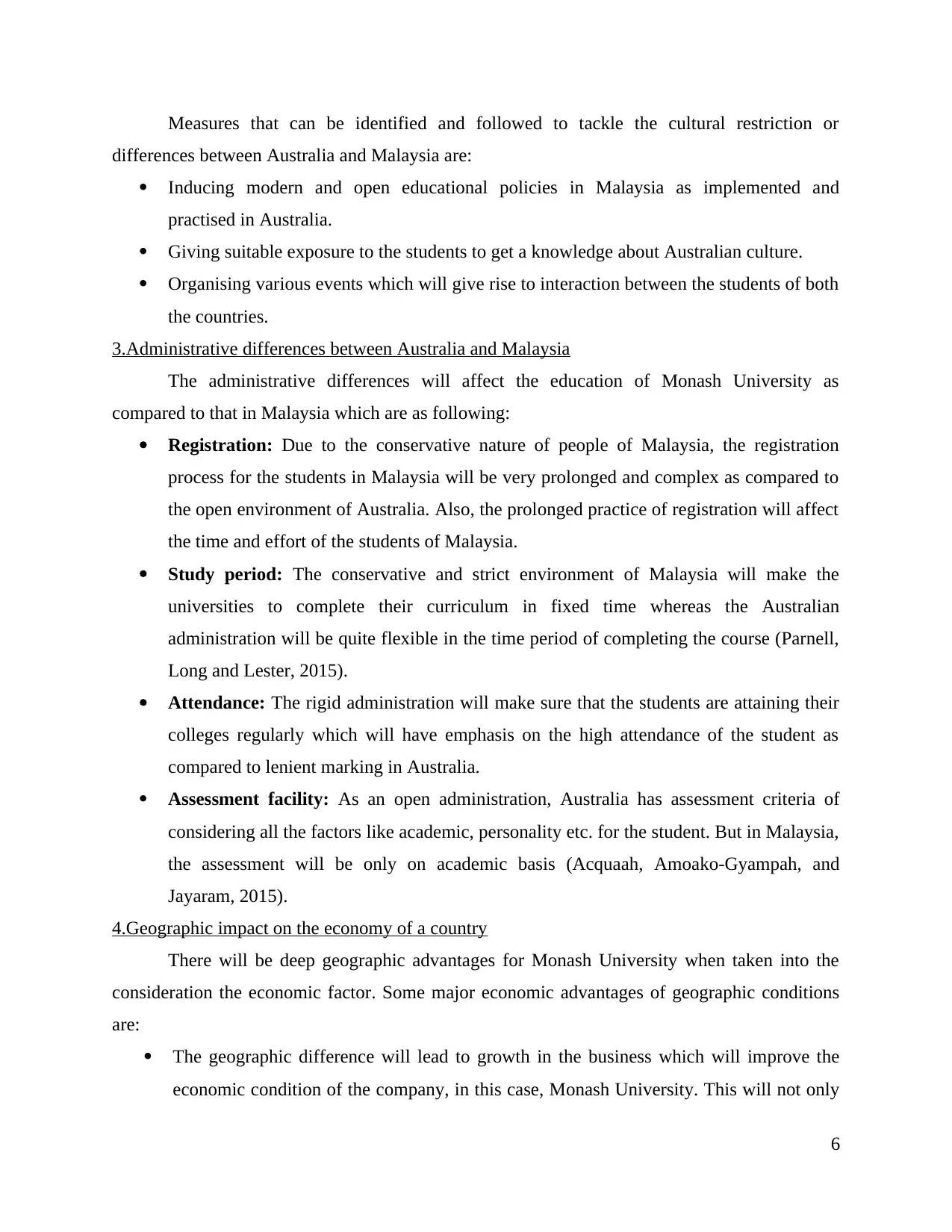
Measures that can be identified and followed to tackle the cultural restriction or
differences between Australia and Malaysia are:
Inducing modern and open educational policies in Malaysia as implemented and
practised in Australia.
Giving suitable exposure to the students to get a knowledge about Australian culture.
Organising various events which will give rise to interaction between the students of both
the countries.
3.Administrative differences between Australia and Malaysia
The administrative differences will affect the education of Monash University as
compared to that in Malaysia which are as following:
Registration: Due to the conservative nature of people of Malaysia, the registration
process for the students in Malaysia will be very prolonged and complex as compared to
the open environment of Australia. Also, the prolonged practice of registration will affect
the time and effort of the students of Malaysia.
Study period: The conservative and strict environment of Malaysia will make the
universities to complete their curriculum in fixed time whereas the Australian
administration will be quite flexible in the time period of completing the course (Parnell,
Long and Lester, 2015).
Attendance: The rigid administration will make sure that the students are attaining their
colleges regularly which will have emphasis on the high attendance of the student as
compared to lenient marking in Australia.
Assessment facility: As an open administration, Australia has assessment criteria of
considering all the factors like academic, personality etc. for the student. But in Malaysia,
the assessment will be only on academic basis (Acquaah, Amoako-Gyampah, and
Jayaram, 2015).
4.Geographic impact on the economy of a country
There will be deep geographic advantages for Monash University when taken into the
consideration the economic factor. Some major economic advantages of geographic conditions
are:
The geographic difference will lead to growth in the business which will improve the
economic condition of the company, in this case, Monash University. This will not only
6
differences between Australia and Malaysia are:
Inducing modern and open educational policies in Malaysia as implemented and
practised in Australia.
Giving suitable exposure to the students to get a knowledge about Australian culture.
Organising various events which will give rise to interaction between the students of both
the countries.
3.Administrative differences between Australia and Malaysia
The administrative differences will affect the education of Monash University as
compared to that in Malaysia which are as following:
Registration: Due to the conservative nature of people of Malaysia, the registration
process for the students in Malaysia will be very prolonged and complex as compared to
the open environment of Australia. Also, the prolonged practice of registration will affect
the time and effort of the students of Malaysia.
Study period: The conservative and strict environment of Malaysia will make the
universities to complete their curriculum in fixed time whereas the Australian
administration will be quite flexible in the time period of completing the course (Parnell,
Long and Lester, 2015).
Attendance: The rigid administration will make sure that the students are attaining their
colleges regularly which will have emphasis on the high attendance of the student as
compared to lenient marking in Australia.
Assessment facility: As an open administration, Australia has assessment criteria of
considering all the factors like academic, personality etc. for the student. But in Malaysia,
the assessment will be only on academic basis (Acquaah, Amoako-Gyampah, and
Jayaram, 2015).
4.Geographic impact on the economy of a country
There will be deep geographic advantages for Monash University when taken into the
consideration the economic factor. Some major economic advantages of geographic conditions
are:
The geographic difference will lead to growth in the business which will improve the
economic condition of the company, in this case, Monash University. This will not only
6
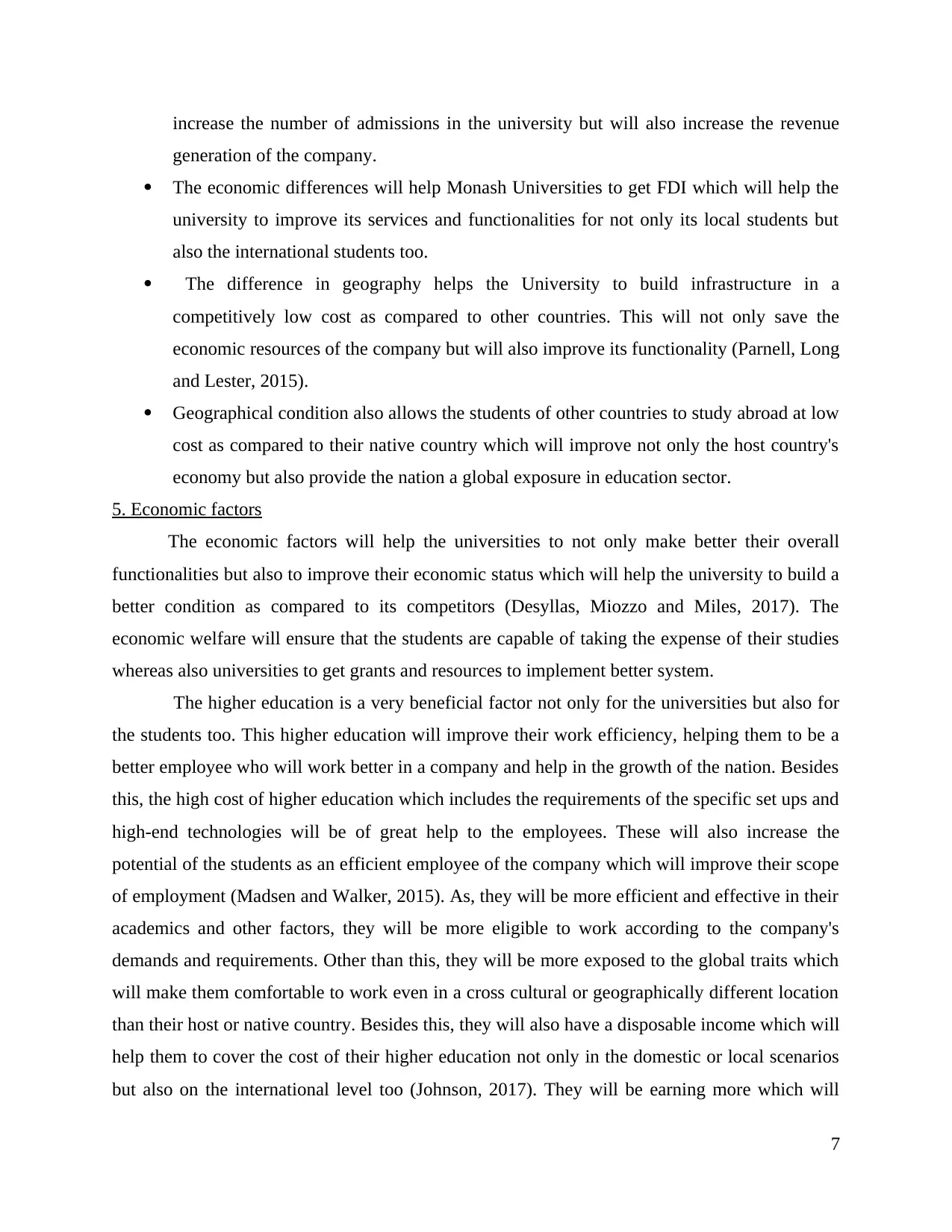
increase the number of admissions in the university but will also increase the revenue
generation of the company.
The economic differences will help Monash Universities to get FDI which will help the
university to improve its services and functionalities for not only its local students but
also the international students too.
The difference in geography helps the University to build infrastructure in a
competitively low cost as compared to other countries. This will not only save the
economic resources of the company but will also improve its functionality (Parnell, Long
and Lester, 2015).
Geographical condition also allows the students of other countries to study abroad at low
cost as compared to their native country which will improve not only the host country's
economy but also provide the nation a global exposure in education sector.
5. Economic factors
The economic factors will help the universities to not only make better their overall
functionalities but also to improve their economic status which will help the university to build a
better condition as compared to its competitors (Desyllas, Miozzo and Miles, 2017). The
economic welfare will ensure that the students are capable of taking the expense of their studies
whereas also universities to get grants and resources to implement better system.
The higher education is a very beneficial factor not only for the universities but also for
the students too. This higher education will improve their work efficiency, helping them to be a
better employee who will work better in a company and help in the growth of the nation. Besides
this, the high cost of higher education which includes the requirements of the specific set ups and
high-end technologies will be of great help to the employees. These will also increase the
potential of the students as an efficient employee of the company which will improve their scope
of employment (Madsen and Walker, 2015). As, they will be more efficient and effective in their
academics and other factors, they will be more eligible to work according to the company's
demands and requirements. Other than this, they will be more exposed to the global traits which
will make them comfortable to work even in a cross cultural or geographically different location
than their host or native country. Besides this, they will also have a disposable income which will
help them to cover the cost of their higher education not only in the domestic or local scenarios
but also on the international level too (Johnson, 2017). They will be earning more which will
7
generation of the company.
The economic differences will help Monash Universities to get FDI which will help the
university to improve its services and functionalities for not only its local students but
also the international students too.
The difference in geography helps the University to build infrastructure in a
competitively low cost as compared to other countries. This will not only save the
economic resources of the company but will also improve its functionality (Parnell, Long
and Lester, 2015).
Geographical condition also allows the students of other countries to study abroad at low
cost as compared to their native country which will improve not only the host country's
economy but also provide the nation a global exposure in education sector.
5. Economic factors
The economic factors will help the universities to not only make better their overall
functionalities but also to improve their economic status which will help the university to build a
better condition as compared to its competitors (Desyllas, Miozzo and Miles, 2017). The
economic welfare will ensure that the students are capable of taking the expense of their studies
whereas also universities to get grants and resources to implement better system.
The higher education is a very beneficial factor not only for the universities but also for
the students too. This higher education will improve their work efficiency, helping them to be a
better employee who will work better in a company and help in the growth of the nation. Besides
this, the high cost of higher education which includes the requirements of the specific set ups and
high-end technologies will be of great help to the employees. These will also increase the
potential of the students as an efficient employee of the company which will improve their scope
of employment (Madsen and Walker, 2015). As, they will be more efficient and effective in their
academics and other factors, they will be more eligible to work according to the company's
demands and requirements. Other than this, they will be more exposed to the global traits which
will make them comfortable to work even in a cross cultural or geographically different location
than their host or native country. Besides this, they will also have a disposable income which will
help them to cover the cost of their higher education not only in the domestic or local scenarios
but also on the international level too (Johnson, 2017). They will be earning more which will
7
⊘ This is a preview!⊘
Do you want full access?
Subscribe today to unlock all pages.

Trusted by 1+ million students worldwide
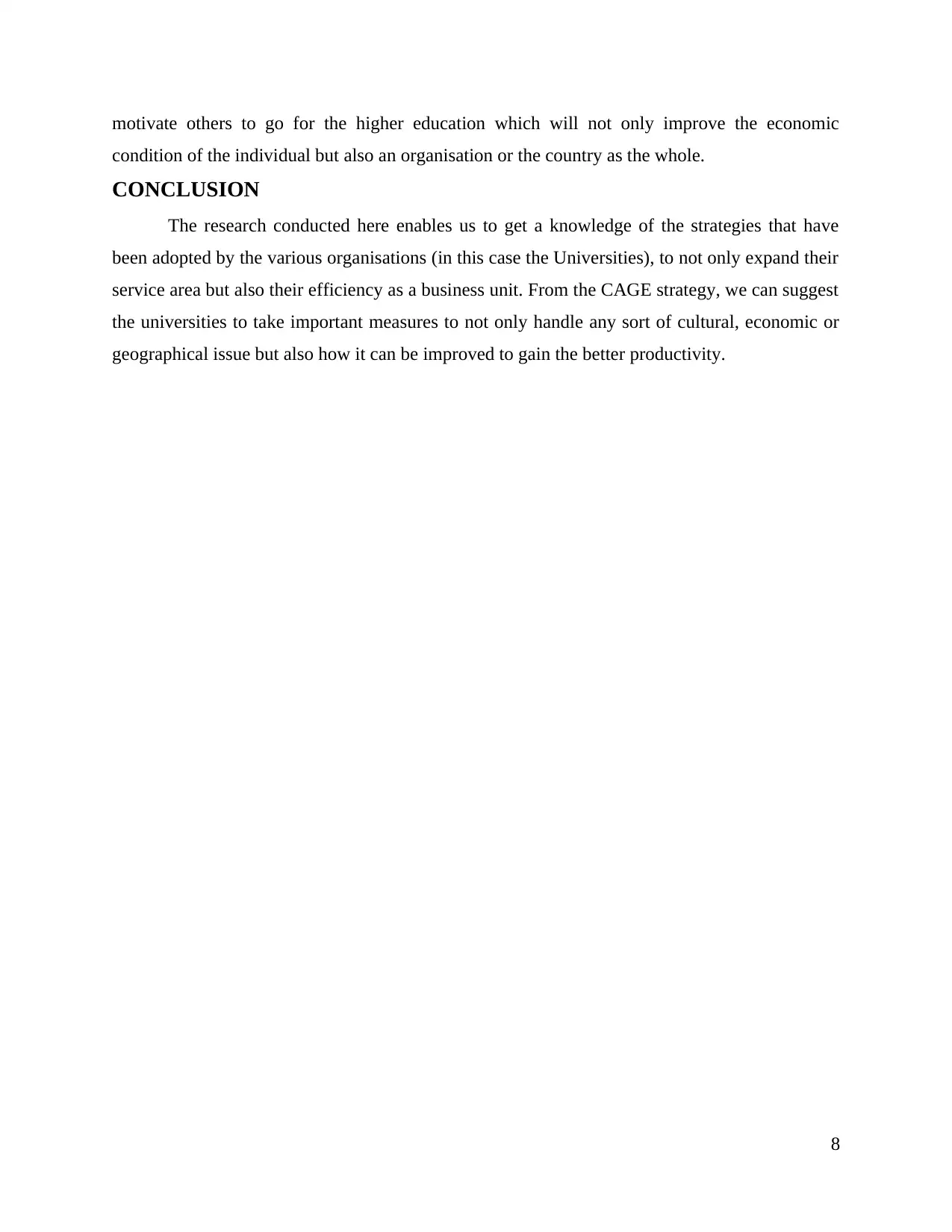
motivate others to go for the higher education which will not only improve the economic
condition of the individual but also an organisation or the country as the whole.
CONCLUSION
The research conducted here enables us to get a knowledge of the strategies that have
been adopted by the various organisations (in this case the Universities), to not only expand their
service area but also their efficiency as a business unit. From the CAGE strategy, we can suggest
the universities to take important measures to not only handle any sort of cultural, economic or
geographical issue but also how it can be improved to gain the better productivity.
8
condition of the individual but also an organisation or the country as the whole.
CONCLUSION
The research conducted here enables us to get a knowledge of the strategies that have
been adopted by the various organisations (in this case the Universities), to not only expand their
service area but also their efficiency as a business unit. From the CAGE strategy, we can suggest
the universities to take important measures to not only handle any sort of cultural, economic or
geographical issue but also how it can be improved to gain the better productivity.
8
Paraphrase This Document
Need a fresh take? Get an instant paraphrase of this document with our AI Paraphraser
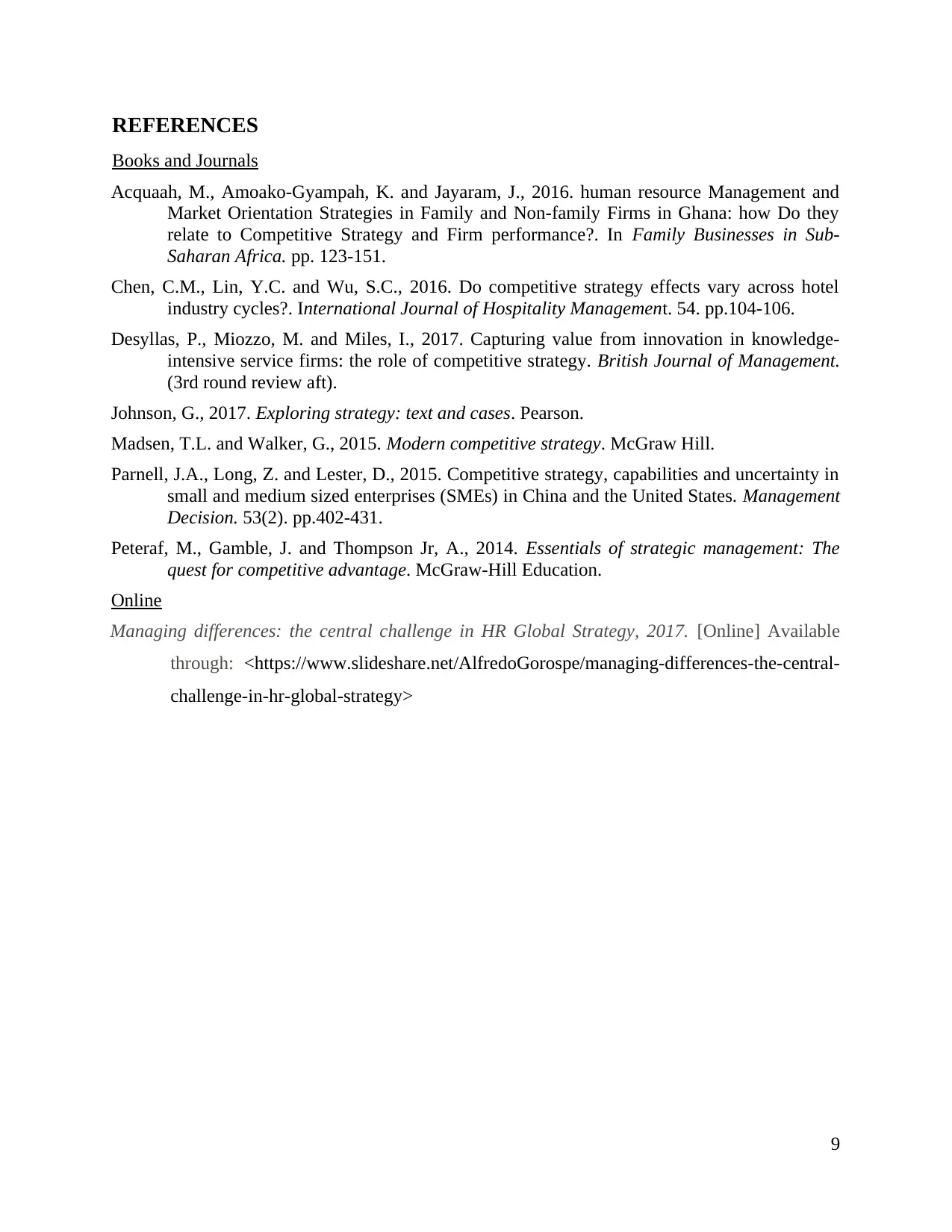
REFERENCES
Books and Journals
Acquaah, M., Amoako-Gyampah, K. and Jayaram, J., 2016. human resource Management and
Market Orientation Strategies in Family and Non-family Firms in Ghana: how Do they
relate to Competitive Strategy and Firm performance?. In Family Businesses in Sub-
Saharan Africa. pp. 123-151.
Chen, C.M., Lin, Y.C. and Wu, S.C., 2016. Do competitive strategy effects vary across hotel
industry cycles?. International Journal of Hospitality Management. 54. pp.104-106.
Desyllas, P., Miozzo, M. and Miles, I., 2017. Capturing value from innovation in knowledge-
intensive service firms: the role of competitive strategy. British Journal of Management.
(3rd round review aft).
Johnson, G., 2017. Exploring strategy: text and cases. Pearson.
Madsen, T.L. and Walker, G., 2015. Modern competitive strategy. McGraw Hill.
Parnell, J.A., Long, Z. and Lester, D., 2015. Competitive strategy, capabilities and uncertainty in
small and medium sized enterprises (SMEs) in China and the United States. Management
Decision. 53(2). pp.402-431.
Peteraf, M., Gamble, J. and Thompson Jr, A., 2014. Essentials of strategic management: The
quest for competitive advantage. McGraw-Hill Education.
Online
Managing differences: the central challenge in HR Global Strategy, 2017. [Online] Available
through: <https://www.slideshare.net/AlfredoGorospe/managing-differences-the-central-
challenge-in-hr-global-strategy>
9
Books and Journals
Acquaah, M., Amoako-Gyampah, K. and Jayaram, J., 2016. human resource Management and
Market Orientation Strategies in Family and Non-family Firms in Ghana: how Do they
relate to Competitive Strategy and Firm performance?. In Family Businesses in Sub-
Saharan Africa. pp. 123-151.
Chen, C.M., Lin, Y.C. and Wu, S.C., 2016. Do competitive strategy effects vary across hotel
industry cycles?. International Journal of Hospitality Management. 54. pp.104-106.
Desyllas, P., Miozzo, M. and Miles, I., 2017. Capturing value from innovation in knowledge-
intensive service firms: the role of competitive strategy. British Journal of Management.
(3rd round review aft).
Johnson, G., 2017. Exploring strategy: text and cases. Pearson.
Madsen, T.L. and Walker, G., 2015. Modern competitive strategy. McGraw Hill.
Parnell, J.A., Long, Z. and Lester, D., 2015. Competitive strategy, capabilities and uncertainty in
small and medium sized enterprises (SMEs) in China and the United States. Management
Decision. 53(2). pp.402-431.
Peteraf, M., Gamble, J. and Thompson Jr, A., 2014. Essentials of strategic management: The
quest for competitive advantage. McGraw-Hill Education.
Online
Managing differences: the central challenge in HR Global Strategy, 2017. [Online] Available
through: <https://www.slideshare.net/AlfredoGorospe/managing-differences-the-central-
challenge-in-hr-global-strategy>
9
1 out of 11
Related Documents
Your All-in-One AI-Powered Toolkit for Academic Success.
+13062052269
info@desklib.com
Available 24*7 on WhatsApp / Email
![[object Object]](/_next/static/media/star-bottom.7253800d.svg)
Unlock your academic potential
Copyright © 2020–2025 A2Z Services. All Rights Reserved. Developed and managed by ZUCOL.




